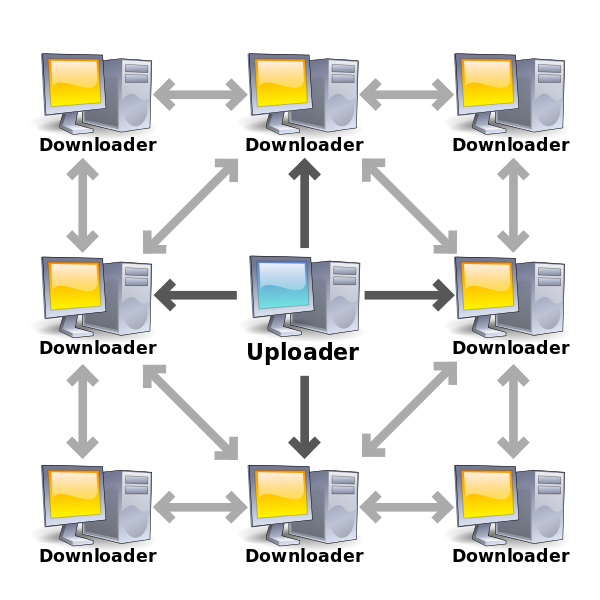
Torrenting is a phenomenon that has been around for more than 15 years and it still remains one of the most popular ways to share files. It combines peer-to-peer technology with distributed hash tables (DHT). This means that even though there are thousands of people sharing the same file, each person downloads only what they need and thus no mass copying or downloading takes place. More importantly, this makes it impossible to trace who uploaded a given file and how many times it was downloaded by anyone else.,
Torrenting is a process that allows users to download files from other people. This process is done by sharing the file with other people, who then share it with other people, and so on. The original file remains intact while being shared over and over again.
Torrenting is a fantastic method to get things from the internet. It’s been around for a long time and has a variety of genuine applications. It may, however, be used to unlawfully distribute copyrighted content. We shall address the question “What is Torrenting?” in this post. We’ll look at how it works and what you’ll need to accomplish it legally and securely.
What exactly is torrenting?
To grasp the idea of torrenting, you must first comprehend the definition of a torrent. A torrent is a tiny file that serves as a key for downloading files from other users. A torrent is a tiny file containing information about the items you wish to download. It does not include any of the information you’re searching for; instead, it serves as a reference to the content you’re seeking for.
A “torrent” file is just a short document that includes instructions for downloading files from other users who are also members of the same file-sharing network (a peer-to-peer or PTP connection). A torrent site, such as Pirate Bay, may be used to get the file. You may begin downloading files from other users after the file has been downloaded to your computer and opened with a BitTorrent client.

Torrenting is a method of obtaining files via the internet. Peer-to-peer file sharing is used, which implies that many individuals may upload and download files at the same time. When someone uploads data, a portion of it is downloaded to their computer, which they may subsequently share with others without having to submit it all again. Other individuals will be downloading as well as uploading. This indicates that a lot of bandwidth is being utilized to distribute the content at all times.
You’ll need special software or applications on your computer called torrent clients to make this kind of file sharing function. You may use them to start and stop downloads as well as see which files are ready to upload.
What Is Torrenting and How Does It Work?
Torrenting works by allowing users to share data with one another. If you wish to download a file, your computer will connect to other computers that are also doing so. You may spread the download process among everyone by connecting so that it is not only downloaded from a single source (i.e., the uploader).
The file you wish to download is divided into multiple parts, which are shared among all those who are downloading it. This implies that various users may download different portions of the file, and everyone is pooling their bandwidth to get the whole file downloaded. This implies that everyone is assisting one another in finishing the download, which makes things go faster for everyone.
To learn more, watch the video below.
What is the Process of Creating and Distributing Torrent Files?
Torrent clients such as BitTorrent or uTorrent may be used to download files. These applications connect to the tracker as well as other torrent peers. When another user who wants to download the file does so, their machine acts as a seed, uploading portions of the file while downloading others. Because you may download from many sources at once and upload to others concurrently, the larger the number of people downloading the content, the quicker it will download.
A tracker is used in the BitTorrent protocol to coordinate activities amongst peers (computers on a network that is sharing files). A single tracker is centralized, however decentralized tracking has been created in recent years to reduce the chance of tracker failure.
Trackers maintain records on each torrent that include a list of all current seeds and leachers; this is how peers may locate each other quickly. Instead than utilizing centralized trackers, peers may utilize remote trackers that are coordinated by adding URLs to.torrent files.
How Are Torrents Disseminated?
Pieces are used to split torrents into smaller sections. Torrents are also known as peer-to-peer (PTP) networks since each of these files is hosted by various computers (called peers) all over the globe.
When you use the Torrent protocol to download a file, your client software connects to the peers and downloads parts from them one by one. These files are downloaded and stored on your computer’s memory or hard disk. You must first download a Torrent file in order to begin this download.

When the Torrent client gets seeds from additional Internet peers, it begins to download the file from those peers as well. In a typical Torrent download, your client gets bits from a variety of sources and then assembles them in memory before delivering them to the peer who requested them. This is when leaches and seeders, two different kinds of torrents, come into play.
Is Torrenting a Risky Business?
If you are downloading materials that have been made accessible for free and legally, torrenting is completely safe. Torrents are often used to obtain open source software or other kinds of media that have become public domain (such as music, movies or books).
However, it is unlawful to download anything that has not been made accessible for free (such as music files) if there are copyright problems. Many websites that market themselves as “torrent sites” enable users to submit copyrighted content that other members of the site may download. This implies that it is up to each individual user to decide whether or not to distribute copyrighted content.
Is it Legal to Torrent?
Torrenting is a legal activity in and of itself; however, the kind of files you download will decide whether or not your actions are deemed unlawful. Torrents may be used to share material such as music, movies, and software applications both legally and unlawfully. Torrenting is often used to distribute open-source software, such as Linux distributions, that has been made freely accessible for distribution.
Torrent sites, on the other hand, enable users to illegally download copyrighted items such as music and movies. Torrenting is a legal form of file sharing, but it may also be used for illicit purposes, so be sure your actions are legal.
The Top 5 Torrent Clients
BitTorrent is number one.
It’s simple to understand why BitTorrent is the original torrent client. Despite the fact that many alternative programs have been on the market in recent years, BitTorrent remains one of the most popular options for private and business file sharers.
UTorrent is number two.
UTorrent is one of the most popular torrent clients, with a variety of features that appeal to beginners. Those who often exchange files may appreciate the option to continue downloads after quitting the application or resetting their computer.
3. Vuze
Vuze is a torrent software that allows you to share files with other people through peer-to-peer networks. It’s one of the more flexible clients on our list, supporting both the BitTorrent protocol and eDonkey – if none of the others meet your requirements, give this software a go.
4. Deluge
Deluge is a lightweight torrent client that has all of the essential features for sharing files with others. It’s simple enough for novice users to get started with, but experienced downloaders will enjoy the choices.
5. Tixati
Tixati is a fast, efficient, and user-friendly BitTorrent client with one of the finest user interfaces available. It supports both superpeers and DHT, making it ideal for both private users exchanging files with friends and commercial usage on public trackers.
To summarize, torrenting is a legal means of file distribution, but it may potentially be used for illegal reasons. The legality of utilizing it is determined by the kinds of information exchanged and whether or not copyrighted material is shared (which is illegal in most countries).
If you want to use Torrents legally, make sure your download doesn’t include any copyrighted content, and always read the terms and conditions of a website before downloading anything. I hope this post has addressed any of your torrent-related questions. Please leave a comment if you have any more!
Articles Related to This:
Which is better, a game console or a computer?
What is Chromecast and Why Do People Use It?
What Should You Be Aware Of When It Comes To Laptop Maintenance?
In the “What Is Torrenting And How Does It Work?” article, I have explained what torrenting is and how it works. In this article, I have updated the information from years ago to reflect current trends in torrenting. Reference: is torrenting illegal in india.
Frequently Asked Questions
Can you go to jail for Torrenting?
A: Torrenting is not illegal but using a service that assists the distribution of data without consent from their owners could be. Something like uTorrent or BitTorrent where you can only download things, not upload to it would still be considered legal if they did not facilitate copyright infringement.
Is Torrenting still a thing?
A: Yes, it is still a thing. Torrenting is the process of sharing data over the Internet using peer-to-peer file sharing protocols.
What is the point of Torrenting?
A: Torrenting is the act of downloading/uploading files by using peer-to-peer file sharing. Files are downloaded from people who have them to those who want them, while uploaders get paid for their downloads with a share of ad revenue or donations.
Related Tags
- is torrenting illegal
- torrenting without vpn
- is torrenting safe
- bittorrent download
- is torrenting dangerous











